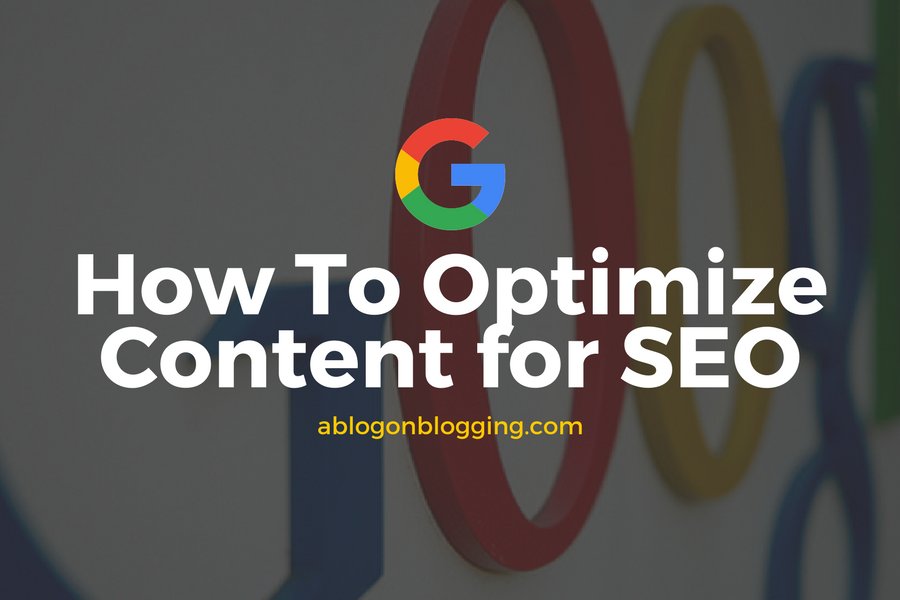Trying to figure out what Google wants will make your head spin. You can get a lot of information on the web about the technical aspects of SEO. Keywords, link building and 404 fixes are all important.
But let’s focus on content for a few minutes. After all, content is the fuel that drives your site’s SEO. This fact may agitate you a bit if you’re not a writer. But guess what; lots of people successfully optimize their content despite their lack of writing prowess.
So if you’re a non-writer needing advice on optimizing content, here are seven tips you need to know before you publish your post.

Yes! Syntax Does Matter
Believe or not, Google’s algorithm can actually detect bad writing. This is probably why so many people neglect their content. After all, who has hours to spend on writing a ‘good’ article?
I’m going to be straight with you; you need a writer if you want good content for your website. But I’m also sorry to say that good writers are very hard to find. Mistakes in your content will only set you back even further.
Okay, enough negativity. I’ve made loads of mistakes sourcing good writers, so here’s some free advice that will save you a lot of frustration:
- First, find a reliable freelancing platform that sources top notch writers.
- Second, search for a writer who is native English. They charge a bit more, but they know how to make your content flow well.
- Pay for a sample. Make sure you’re investing in a writer who really understands your niche. Pay for one article. If it’s a success, go ahead and order regular work.
Once you have an article that’s written well, you can optimize it yourself without paying a professional. Let’s see what else you need to do.
The Ideal Blog Length
Google has never officially stated what blog length they prefer. However, research proves that this is an important factor in their ranking criteria.
Studies show that blogs of between 1800 and 2000 words rank higher than the rest. Why is this?
- This length covers a topic well.
- It isn’t too short, but it’s also not too long. Readers who are serious about the topic will stay long enough to read it till the end.
- A blog of this length can be broken down into manageable sections, each one contributing to the topic in question.
Those 400 word blogs you’ve been writing simply won’t cut it anymore. It’s time to give your readers what they really want. Note the emphasis on READERS, not Google. Google is only a search engine that indexes your content against all others. Essentially, you’re writing for people.
The Importance of Images
You wouldn’t think that images have any weight regarding your content—but they do.
Images are referenced by Google to check the following points:
- Is the image relevant to the article?
- Is the image high quality?
- Does the image have a suitable tag?
- Is the image original?
- Is the image responsive?
In a nutshell, the perfect image for your article would be:
- One that you sourced from a professional, or captured yourself.
- It will also be of a high resolution, but not too large to exceed Google’s ideal size (2500 x 1500).
- Furthermore, the image will have a description that describes it appropriately and helps Google index it properly.
- Finally, the image will suit your article as opposed to being random or displaced.
Note once again that these pointers are not to please Google. People simply respond better to images that are relevant, descriptive and pleasant to look at. Google has simply quantified these human likes into their algorithm.
If you’re posting images with your articles (and you should), either hire a professional photographer or purchase your images off reputable sites. If it helps you rank better, it’s well worth spending that little bit extra.
Understanding Headers
Do you get the whole H1, H2 header thing? A lot of people don’t, but it’s actually quite simple.
Here’s a basic explanation:
Articles should be broken into smaller parts that are easy to digest. It’s a good idea to categorize these sections and name them.
- An H1 header is a title or the headline of the article. This tells the reader what they are about to read.
- The H2 headers are the subtitles. Readers may be looking for something specific in the article without the need to read through the whole piece. H2 headers allow them to scan through it and settle on the section they are looking for.
- H3 headers are sections that have been further broken down within the subsections. This helps readers reference smaller details within the article.
Google loves articles that are structured this way. Its algorithm recognizes that people are more likely to get the info they need if the article is broken down into easy-to-digest sections.
Google will also look for lots of bullet points. This is another way to digest information fast and effectively without wasting too much time.
Basically if you can write a 2000 word article that can be read in a few minutes, you’ve got a winner! And yes, it is possible.

Comments and Sharing
It goes without saying that sharing your blogs will help you rank well. It’s also clear that commenting has a highly positive effect on your authority on your niche.
So how can you encourage comments and shares? Here are some ways:
- Start off by giving readers the option to share. If your blog pages don’t have social media share buttons, don’t expect people to copy your URL on their own accord.
- Make sure your articles are interesting enough to share. If it doesn’t contribute to someone’s life in some way, they will not want to spread it around.
- If/when someone does comment, respond to that comment. Many blogs fail because the publisher stopped engaging his or her readers.
- Publish your articles on social media. People are more likely to share directly on platforms such as Facebook because of convenience.
Google will notice when your blogs get comments and shares. Encourage this as much as possible by following the above steps.
Connect Your Articles With Each Other
Linking your articles together creates a chain reaction that Google notices. When all your ideas come together in harmony, it sends a signal to your readers that you are consistent in your thought process.
Also remember that people may want to get more information by referencing previous articles. This further strengthens your authority, which is ALWAYS good!
Another advantage to linking your own articles within themselves is internal link building. Google will rank you higher if it sees several relevant links spread out across your blogs and your website pages.
Here are examples of a relevant link and a link that’s off balance:
GOOD:
If you’re a believer in companion planting, remember that tomatoes are excellent companions for basil.
BAD:
Tomatoes are excellent companions for basil. Read more about companion planting HERE.
As you can see, using the right words is just as important as the link itself. Don’t forget. “companion planting” comes across as natural, while “HERE” is out of the way and slightly annoying.
Forget About Google
I can read your thoughts. “WHAT? Didn’t I just hear you say that Google looks for certain criteria in order to rank my content?”
Okay settle down. There’s a good reason I’m telling you to forget about Google when you write your content. The fact is Google knows when you’re trying to suck up.
Yes, you heard me. Google’s algorithm is so advanced it can detect when you’re trying to write content for the sole purpose of ranking.
If you look back at everything we’ve discussed so far, you’ll notice that all of them are for people. The fact that Google picks up on what people want is just evidence that their algorithm is that advanced.
Remember this when you get your articles written. Make sure everything you publish is optimized for people, not machines.

Thank you for this post. I am new to having a blog and any tips I can get on seo is great.
Awesome 🙂 thank you for your kind comment. Let me know if I can help you in any way.
Hi Copley. I think your last point is the most important one. In my opinion people get way too excited about SEO and Google’s algorithm. Google has clearly stated many times that their one and only goal is to find the content that satisfies what someone is searching for. That’s it.
If you focus your writing on providing the answers that people are searching for then you’re already 80% of the way there. If you really answer their question, then all of Google’s algorithm changes are just to refine Google’s ability to find and understand your content.
That’s exactly what I see SEO as. People like to make it some big, scary, complicated thing. It isn’t. All you do with SEO is make it easier for Google to understand what your content is about. In well written content the titles, headings, and picture descriptions all indicate what your content is about, so you don’t really have to worry about them all that much.
Just my thoughts.
Nice website. You give the reader plenty of good information on writing a good blog and how to get ratings in google. Also, you provide plenty of good content and complement it with nice visuals. I especially enjoyed your 7 tips for non-writers in SEO. I will try to get my pages to be in the 1800 to 2000 word length that you suggested. The key is still writing good content which you pointed out. Images are extremely important as you stated. No sense putting up a picture if it is inappropriate for the content one is writing. Again very well done, I hope you do well with your website!
Thank you Mick for your kind words.Glad you found my website engaging and insightful. 🙂